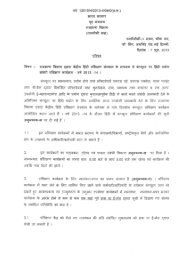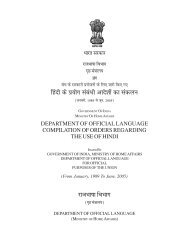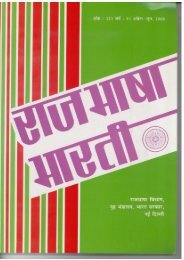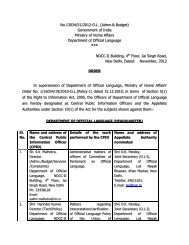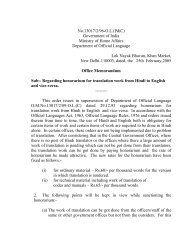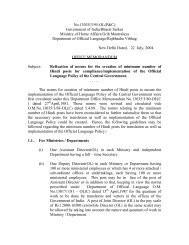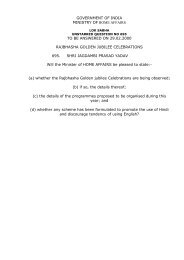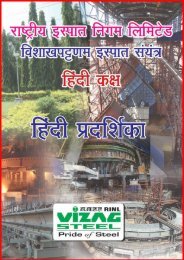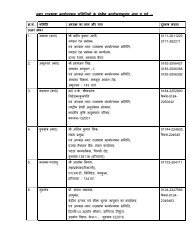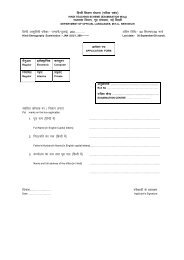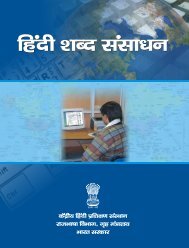Evaluation of Plan Schemes of the Department of Official Language
Evaluation of Plan Schemes of the Department of Official Language
Evaluation of Plan Schemes of the Department of Official Language
You also want an ePaper? Increase the reach of your titles
YUMPU automatically turns print PDFs into web optimized ePapers that Google loves.
journal Rajbhasha Bharti) indicate that <strong>the</strong>re is dissatisfaction with <strong>the</strong><br />
extent <strong>of</strong> usage.<br />
But all this is only suggestive. It is surprising that little policy relevant<br />
information is available regarding <strong>the</strong> extent <strong>of</strong> usage <strong>of</strong> Hindi over <strong>the</strong> years<br />
and across regions and <strong>of</strong>fices. It is difficult, for example, for an outsider<br />
or even <strong>the</strong> policy-maker to know whe<strong>the</strong>r <strong>the</strong> extent <strong>of</strong> usage <strong>of</strong> Hindi has<br />
increased between two years and, if so, to what extent. This is because <strong>the</strong><br />
coverage <strong>of</strong> <strong>the</strong> Annual Assessment Report differs year to year and <strong>the</strong> data<br />
is not processed (i.e. added or percentages deduced) to yield information.<br />
The precise meanings <strong>of</strong> <strong>the</strong> measures are <strong>of</strong>ten not clear. Also <strong>the</strong> manner<br />
in which <strong>the</strong> data are collected is not known. For instance, it is not clear to<br />
an analyst as to what is included under <strong>the</strong> heading “Percentage <strong>of</strong> Hindi<br />
Work to Total Work” (reported in <strong>the</strong> Annual Assessment Reports) and how<br />
this data is collected in different departments etc. It appears that whatever<br />
is reported by <strong>the</strong> various departmental/<strong>of</strong>fice heads are simply accepted<br />
and reported. The DOL does have an Annual Programme (generally a<br />
routine document) but <strong>the</strong>re is no way to know as to what extent <strong>the</strong> targets<br />
are achieved annually. The DOL does conduct inspections and <strong>the</strong>se could<br />
be ano<strong>the</strong>r important source <strong>of</strong> data. Outside analysts and policy-makers<br />
would be benefited if <strong>the</strong> manner <strong>of</strong> <strong>the</strong> conduct <strong>of</strong> language audit and <strong>the</strong><br />
results are made available to citizens.<br />
GENERAL RECOMMENDATIONS:<br />
The DOL’s monitoring and evaluation capacity <strong>the</strong>refore needs to be<br />
streng<strong>the</strong>ned and pr<strong>of</strong>essionalized. The regular monitoring system<br />
needs to be revamped and supplemented by sample based impact<br />
audits to know not only <strong>the</strong> extent <strong>of</strong> usage but also to identify <strong>the</strong><br />
factors that are retarding <strong>the</strong> spread <strong>of</strong> <strong>the</strong> language in <strong>of</strong>ficial usage.<br />
42



